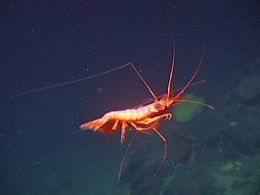Eyesight of mantis shrimp reveals a new observation mode of animals
According to the article by Current Biology researchers published on March 20, 2008, mantis shrimp can be seen in an unprecedented way in any other animal before. This discovery marked the presence of a fourth-class vision system, and it also showed that the ability to receive circularly polarized light may have given the mantis shrimp a way of communicating. secret.
Justin Marshall of the University of Queensland, Australia said: 'Mantis shrimp has ventured into a new vision limit.' Mantis shrimp also has the name stomatopods . They are a large crustacean that lives in the sea and is particularly violent. They are not shrimp but look like shrimp.
As Marshall describes, circularly polarized light is twisted, it can move circularly to the right or to the left. Previous scientists have demonstrated that some animals, such as beetles, have the ability to reflect this type of light. But they have never proven that animals can see that light until now.
Marshall said: 'This is a complex physical phenomenon, but more interesting is that some animals can use this phenomenon for a certain purpose' . To do this requires stomatopods to form a membrane in their eyes that is at an angle of exactly 45 ° compared to polarized light receiving cells in the lower line. The filter turns circularly polarized light into a straight form . Many animals can take advantage of linear polarized light. However, people have a feeling of being dazzled with this kind of light so we need sunglasses.

A sea shrimp. (Photo: National Oceanic and Climate Administration)
In the new study, the scientists described a detailed anatomy in stomatopods that makes them very special. They showed that these structures will be stimulated when circular polarized light shines on stomatopods. They also showed behavioral evidence of the ability of stomatopods to use food as a reward for training them to combine circularly polarized light rays to the right (R-CPL) with polarized light. left side (L-CPL).
During the experiment, scientists did not indulge in food but exposed stomatopods to two feed ducts, one L-CPL reflector and the other reflected R-CPL. Stomatopods have chosen CPL reflectors in a way that they have been taught to a considerable extent before.
Although it is still unclear what benefits the wild eyes of this mantis shrimp can have in nature, Marshall thinks it is related to sex. Marshall says stomatopods use special specialized colors and linear polarization signals in their complex social interactions. By using circularly polarized images, Marshall's team identified three species of stomotopods (the same genus Odontodactus) whose circularly polarized light is reflected from the male's cutin shell, not must children. Different sex-reflective areas are located in parts of the body that stomatopods use regularly to show behavior.
The scientists concluded: 'The exact role of CPL-visible vision signals in the signaling of sex in stomatopods has not been clarified. But we think that CPL reflexes can act as a secret communication channel. Animals such as arthropods eating stomatopods can see linear polarization signals used by marine invertebrates. So these signals can be exploited. Other species of stomatopods we have studied have different CPL sensitivity, they may not be able to distinguish sex in Odontodactylus species. Therefore, as a personal communication channel, it has no value for both enemies and potential competitors of stomatopods'.
No matter what the benefits of CPL and CPL vision provide for stomatopods, comparing the structural features of their CPL receptor to the artificial system is also very interesting. People use CPL filters and images in photography, medical imaging, or systems that detect objects in bright environments. Space in coral reefs or waters where stomatopods live is often dark. And perhaps not surprisingly, 400 million years ago, when the first crustacean stomatopods appeared, natural demand came first in such waters.
- Discovering new abilities of mantis shrimp
- Eyes of mantis shrimp
- Video: Scary weapon of hammerhead shrimp
- The unusual eyes of animals (II)
- Pick up strange shrimps, bring them to feed and bitterness
- Developing cameras for unmanned vehicles simulating mantis shrimp sight
- Animals possess supernatural powers
- Video: See the surface of the clam shell
- 10cm shrimp pushes 90kg heavy objects
- Praying Mantis prey with a flower-like shape
- Video: Praying mantis still mating
- Visual illusion reveals your degree of eyesight
 Why do potatoes have eyes?
Why do potatoes have eyes? 'Tragedy' the world's largest carnivorous life: Death becomes ... public toilet
'Tragedy' the world's largest carnivorous life: Death becomes ... public toilet Tomatoes were once considered 'poisonous' for 200 years
Tomatoes were once considered 'poisonous' for 200 years Detecting microscopic parasites on human face
Detecting microscopic parasites on human face